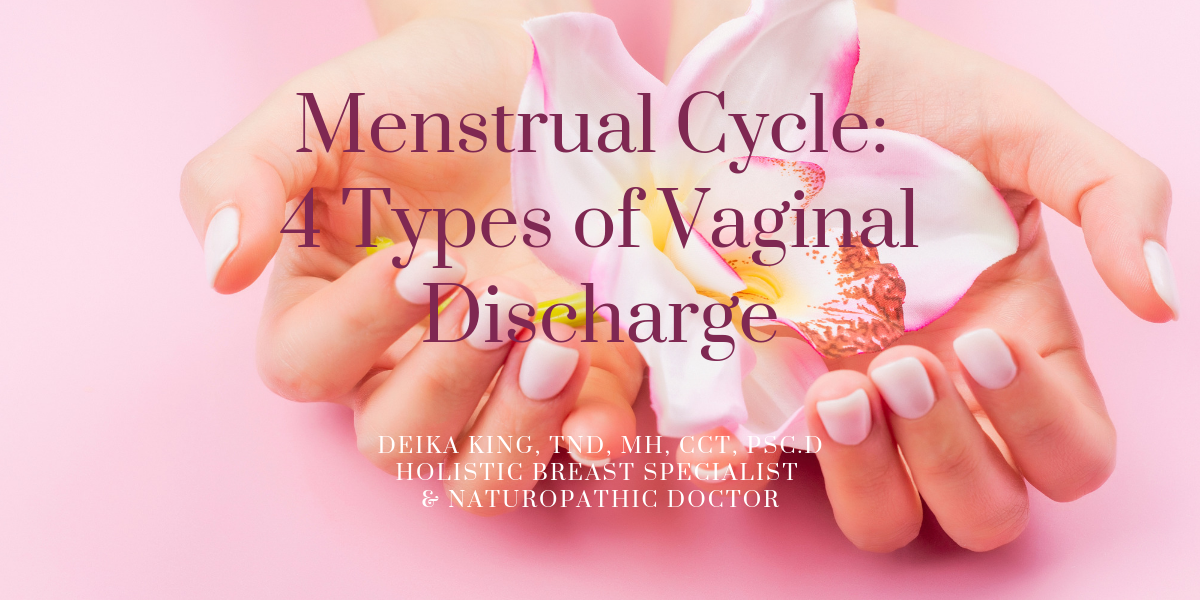Vaginal Discharge is a normal process of your menstrual cycle. Unfortunately, most women are not aware that this is normal, nor do they know what each discharge means.
If you don’t know what is normal to your body, you won’t know what is abnormal and when it’s time to seek help. Today we want to give a brief description of the 4 types of vaginal discharge and what they mean.
Most women will see a vaginal discharge before their menstruation period. This is perfectly normal if the discharge is healthy, has no offensive smell and doesn’t make the vaginal area itchy.
The white vaginal discharges are produced in the cervix, vulva and vaginal walls and are also referred to as cervical mucus. These discharges are a combination of cervical mucus and secretion.
White vaginal discharges are called “leukorrhea”. This discharge is a common symptom that occurs as part of the premenstrual cycle. Research shows that one in eight women experience a significant change in their vaginal discharges before their ovulation period and another distinct change before their menstruation period.
Vaginal discharges are considered normal if a woman is not on any contraceptive pill, and if she is of reproductive age. In fact, a woman who isn’t taking pills and who is in her reproductive years, may expect to have very few days (if any at all) without some form of vaginal discharge.
Characteristics of Vaginal Discharge
The characteristics of these vaginal discharges may vary in consistency and color depending on the time of the woman’s cycle. These discharges may appear:
- Clear watery
- Creamy white
- White watery
- Milky white
- Thick white
The texture, appearance and amount of discharge changes as the hormones fluctuate throughout the menstrual cycle. If a white discharge occurs before the menstruation period, then it is most likely coming from the cervix and uterus. This is not a sign of infection.
Four Types of Vaginal Discharge
The following are the four types of vaginal discharges:
-
Type 1 Vaginal Discharge
This first type is a dry and pasty type of discharge, which makes it hard for the sperm cells to penetrate. This is usually produced during the infertile days. These are the days at the end of the menstruation period and a few days before your next menstruation appears.
This type of discharge means the woman is less likely to fall pregnant at this time.
-
Type 2 Vaginal Discharge
This is a little more liquid, yet a little bit stickier type of discharge. This creamy mucus appears when ovulating. If the menstruation cycle is 28-days, then a woman can expect this type of discharge during the 7th-11th day.
This creamy yet thinner type of discharge is capable of catching and filtering out poor quality sperm and preventing them from entering the uterus.
-
Type 3 Vaginal Discharge
This is the egg-white-like mucus, slippery type of discharge that appears when the ovulation period approaches. This creates strings of discharge that sometimes appears in combination with a clumpy discharge of creamy white fluid.
If you have this type of discharge, it clearly signifies that you are ovulating. Its egg-white like consistency makes a perfect pathway for sperm to enter the uterus.
-
Type 4 Vaginal Discharge
The fourth type of discharge creates a slippery sensation in a woman’s vulva. This is when the mucus loses its “stretchy” consistency and turn out to be more lubricating.
When this type of discharge appears, it means the woman is extremely fertile. This is the also the time when the egg is released.
If you are having any type of menstrual cycle imbalance and would like some assistance, please don’t hesitate to schedule an appointment with us here.
Deika King, TND, MH, CCT, PSc.D
Traditional Doctor of Naturopathy Houston
832-422-7271







